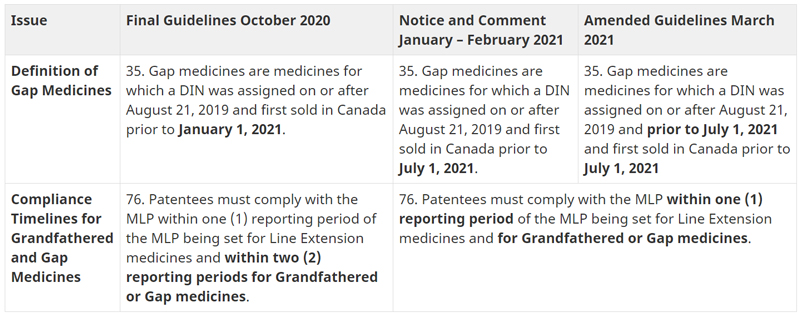This article was originally authored by Abigail Smith.
Update: See our April 29, 2021 article reporting an update to compliance timelines for Grandfathered and Gap medicines. Further updates, including to the definition of “Gap medicine” are presently in consultation (see article here).
Consultation results
On March 17, 2021 the Patented Medicine Prices Review Board (PMPRB) announced the result of the Consultation opened in January (reported here) regarding the definition of “Gap Medicine” and compliance timelines for Grandfathered and Gap Medicines.
As proposed, the Guidelines will be amended such that a Gap Medicine will be defined as a medicine for which a Drug Identification Number (DIN) was assigned on or after August 21, 2019, and which was first sold in Canada by July 1, 2021. The PMPRB also clarified that a DIN must have been assigned to the medicine on or after August 21, 2019 but prior to July 1, 2021.
The PMPRB will similarly proceed with its proposed revision to the compliance timeline for Grandfathered and Gap Medicines, such that compliance with the Maximum List Price for Grandfathered and Gap Medicines will be assessed after one reporting period, rather than two. January 1, 2022 will therefore remain the operative date for assessing compliance.

Guidelines clarifications
In its February 2021 NEWSletter, the PMPRB clarified a number of aspects of the new Guidelines.
Notably, the PMPRB has decided that until there is clarity from the Quebec and Federal Courts of Appeal on the status of indirect rebates in the calculation of net Average Transaction Price, price tests that are based on the new excessive pricing factors alone will not give rise to an investigation for failure to comply with the Guidelines. Rather, the PMPRB will commence an investigation into the price of a new patented medicine only if it appears not to comply with the Maximum List Price as set by the PMPRB11 countries, or if a complaint is received.
The PMPRB additionally clarified aspects of the Guidelines relating to price reviews and investigations for COVID-19 vaccines, CPI adjustment factors, foreign price verification, exchange rates, GDP per capita, market size, and highlighted various substantive editorial changes.
Should you have any questions, please do not hesitate to contact a member of the Life Sciences Regulatory & Compliance Group.
The preceding is intended as a timely update on Canadian intellectual property and technology law. The content is informational only and does not constitute legal or professional advice. To obtain such advice, please communicate with our offices directly.
Related Publications & Articles
-
Ontario proposes legislation to regulate preferred provider networks
Following two public consultations with stakeholders, the Government of Ontario (Ministry of Finance) is moving forward with legislation to regulate preferred provider networks (PPNs).Read More -
Canada’s Drug Agency releases new resource and data on drug approval and reimbursement pathway
Canada’s Drug Agency (CDA-AMC) published data on Canada’s drug system as part of the Data Systems and Analytics program.Read More -
PMPRB update: Guidelines for PMPRB Staff come into effect January 1, 2026; 2024 Annual Report
On January 1, 2026, the Guidelines for PMPRB Staff will come into effect. In November, the Patented Medicine Prices Review Board (PMPRB) held information sessions on the Guidelines to share technical ...Read More
